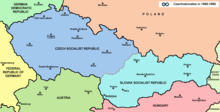Slovak Socialist Republic: Difference between revisions
No edit summary |
added the anthem of slovakia do not include this in czechoslovak anthem as it contains only one verse not the current one! |
||
| Line 26: | Line 26: | ||
|capital = [[Bratislava]] |
|capital = [[Bratislava]] |
||
|national_motto= |
|national_motto= |
||
|national_anthem= [[Nad Tatrou sa blýska]] |
|national_anthem= "{{lang|sk|[[Nad Tatrou sa blýska]]}}"<br />{{raise|0.1em|{{small|"Lightning Over the Tatras"}}}}<br />[[File:Nad Tatrou sa blýska Hromy divo bijú.mp3|center]] |
||
|legislature = [[National Council of the Slovak Republic|Slovak National Council]] |
|legislature = [[National Council of the Slovak Republic|Slovak National Council]] |
||
|event1 = [[Velvet Revolution]] |
|event1 = [[Velvet Revolution]] |
||
Revision as of 05:42, 13 February 2018
| Slovak Socialist Republic (1969–90) Slovenská socialistická republika Slovak Republic (1990–92) Slovenská republika | |||||||||
|---|---|---|---|---|---|---|---|---|---|
| Federal subject of the Czechoslovak Socialist Republic (1969–90) and Czech and Slovak Federative Republic (1990–92) | |||||||||
| 1969–1993 | |||||||||
 Slovak Socialist Republic within CSSR | |||||||||
| Anthem | |||||||||
| "Nad Tatrou sa blýska" "Lightning Over the Tatras" | |||||||||
| Capital | Bratislava | ||||||||
| • Type | Socialist republic (1968–89) Parliamentary republic (1989–92) | ||||||||
| Legislature | Slovak National Council | ||||||||
| History | |||||||||
| 1 January 1969 | |||||||||
| 17 November-29 December 1989 | |||||||||
| 1 January 1993 | |||||||||
| |||||||||
The Slovak Socialist Republic (Slovenská socialistická republika in Slovak; abbreviated SSR) was from 1969 to 1990 the official name of Slovakia. The name was used from 1 January 1969 until March 1990.
History
After the occupation of Czechoslovakia in 1968 liberalisation reforms were halted and then reversed. The only significant exception was the federalization of the country. The former centralist state of Czechoslovakia was divided in two: the Czech Socialist Republic and Slovak Socialist Republic by the Constitutional Law of Federation of 28 October 1968, which came into effect on 1 January 1969. New national parliaments (the Czech National Council and the Slovak National Council) were created and the old parliament of Czechoslovakia was renamed the "Federal Assembly" and was divided in two chambers: the House of the People (cz:Sněmovna lidu / sk:Snemovňa ľudu) and the House of Nations (cz:Sněmovna národů / sk:Snemovňa národov). Very complicated rules of voting were put in effect.
Federalization was notional – all the real power was kept by the Communist Party. The increased number of "parliaments" conveniently provided more positions for party members though their role was just symbolic.
After the fall of socialism in Czechoslovakia, the word "socialist" was dropped in the names of the two republics, i.e. the Slovak Socialist Republic was renamed Slovak Republic (still part of Czechoslovakia, since April 1992 of the Czech and Slovak Federative Republic).
The complicated system of parliamentary voting (there were de facto 5 different bodies each having right of veto) was kept after the fall of socialism, complicating and delaying political decisions during radical changes in the economy.
Later, in 1993, the Slovak Republic became an independent state and officially took the name Slovakia as a short form – see dissolution of Czechoslovakia.
See also
- Slovaks in Czechoslovakia (1960-1990)
- Constitutional Law of Federation
- History of Czechoslovakia
- Czech Socialist Republic
- Czech and Slovak Federative Republic
- Slovak Republic (1939-1945)


